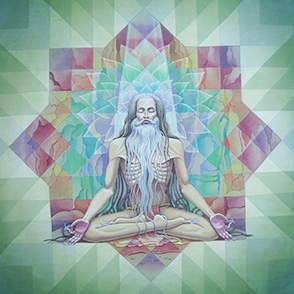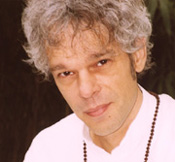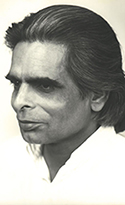Tantric Advaita |

"Samadi" by Pieter Weltevrede
1. Control of action (yama) includes practicing the following “ten yamas”: nonviolence, truth, honesty, sexual continence, forbearance, fortitude, kindness, straightforwardness, moderation in diet, and bodily purity.
 |
Yama & Niyama |
2. Control of attachment (niyama) includes disciplines such as austerity, contentment, faith, charity, worship, study, modesty, alertness, prayer, and sacrifice. Through these regular practices the ego loses its attachments, because these actions are not ego-centered but self-centered or God-centered. When our day has been entirely ego-centered, then our meditation will probably have similar poor quality. Attachments serve only to keep our self-constructed personality alive and keep us away from the self. Thus niyama prepares us for full concentration on the witness consciousness, or the divine.
 |
Asana in Ashtanga Yoga |
3. Control of posture (asana) has a variety of functions, but the central objective is to develop at least one position in which one can sit without movement or pain for a prolonged period, several hours at a time. Without that basic posture control, true meditation becomes very difficult. The posture should be exercised daily on a flat surface, without back support, keeping the spine straight. If you really cannot sit like that, you can still meditate; however, losing body consciousness will become much more difficult, as tension will be located more intensely in a limited area. The easiest way to develop such independent and erect posture is to compel yourself to sit on a flat surface in that same posture every day for gradually increasing lengths of time while you work, read, paint, watch TV, or do whatever you do on a daily basis. People who grew up using chairs will usually require quite a lot of exercise to develop the lower back muscles before they can “sit on their spine” without effort. Just taking a few yoga classes will not be enough. People with small buttocks can use a small cushion to compensate for their lack of inbuilt cushioning—others should try to do without. The most commonly used postures for meditation are the lotus posture, the semi-lotus, the simple cross-legged posture, and a posture of sitting on the heels. There are many good books on this subject, providing a variety of asanas. These can also be of great help to prepare the body for prolonged maintenance of one posture, to release tension, to improve health, and to promote the flow of energy in the body, a valuable tool in achieving the higher stages of meditation.
4. Control of breath (pranayama) means, at the beginning, to develop slow and deep breathing as opposed to rapid and shallow breathing. As breath supplies oxygen to the brain, to slow down breath means to slow down mind. This is easy to experience: just hold your breath for about ten seconds and then continue holding it while trying to do some calculation or other that you normally could do quite easily. You will find it to be a lot more difficult. Some deep breathing techniques are, on the contrary, aimed at saturating the brain with oxygen, as a way to go beyond rational thinking into more intuitive thought. This is more useful for contemplation than for meditation. Through the technique of alternate nostril breathing it is possible to balance the solar and lunar hemispheres of our brain. Again, a variety of good books exists on the subject of breath control. True pranayama includes prolonged breath suspension (kumbhaka), which literally stops mind and causes the upward flow of the kundalini energy in the central energy channel of the spine (the sushumna nadi). This includes the use of blocks (bandhas) that contain pranic energy in certain parts of the body in order to enhance this flow of kundalini energy. Breath is one of the most obvious body-mind tools, and its use before and during meditation is quite logical.
5. Control of the senses (pratyahara) basically means to withdraw the attention from all sensory input. With sound, for example: it is not so much that you stop hearing, but that you stop listening. With sight: closing the eyes is an obvious move, but still you might see a nice light show going on behind closed eyes, as long as you are looking. Keeping the teeth clean may be important to avoid being unconsciously annoyed by unpleasant tastes. Burning some incense or heating some essential oils may serve you to unify the input of smells and then to withdraw from that sense as well. The most difficult input to lose may be the sense of touch, as your body may protest being held in one position for so long; hence the importance of developing a comfortable meditation posture. Here, you need a touch of will in order to disregard the aches and pains, and in this you will be aided by the concentration exercises described in the next step. Breath suspension also helps to block out sensory input.
6. Control of attention (dharana) means to concentrate the mind, to become one-pointed. Concentration does not mean “to think about” the object of concentration, but rather, to fully direct your attention toward it. It is like looking at a book without reading it, or reading it without thinking about it. If the mind is fully focused on the object, thoughts will stop, just as they will stop when you are fully focused on doing some difficult task, like walking over a narrow, dangerous mountain path. The many yoga traditions offer a wide variety of objects for concentration, such as postures, breathing exercises, mantras and seed sounds, yantras and other uplifting visuals of divine energies, rituals, and concepts. The more these objects of focus are used in a simple, slow, and repetitive manner, the more they allow the mind to be quiet. However, to master an agitated mind, more complicated and/or faster exercises work best, because they provide enough variety to engage the mind in the first place. As one progresses along this step, one may move from more complex rituals and practices to more simple objects of focus. A good example is to move from a number of longer mantras toward one short mantra. As long as thoughts still heavily interfere with your concentration exercise, the object of concentration must be made more complicated, more captivating. In any case, the concentration should not be forceful, but peaceful. Whenever the facial muscles become rigid, a headache develops, or a sensation of heat is experienced in the head, you should relax and use a more gentle hold on the object of concentration.
7. Control of thought (dhyana) — which is meditation — starts when one reaches true dharana and thoughts are stopped. True dharana creates a kind of thoughtless void in the experience that allows full concentration on the object. The mind has been brought to rest by being bored or chanted to sleep.
 |
How to Meditate Gayatri Mantra Meditation |
8. The state beyond control (samadhi) then brings full absorption, super consciousness, self-realization, complete balance, supreme truth, eternal bliss, enlightenment. All diversity disappears, all duality ceases.
 |
Samadhi - Deep Meditation |
 Leela is the ancient vedic name for the theater of life. Life in all its forms is an illusion behind which we can find the ultimate truth of pure Being. Yet life is also a divine theater, a spiritual game played by us, the actors. Yoga allows us to hold on to the bliss of truth while playing the game. And also this yoga is a game, which we can only take seriously if we do not take ourselves and this game too seriously. That is the meaning of Leela Yoga, nothing more, nothing less. So, Leela Yoga is a vision on yoga and also a name for a simple organisation that allows me to bring this vision into practice... more about Leela Yoga & Peter Marchand
Leela is the ancient vedic name for the theater of life. Life in all its forms is an illusion behind which we can find the ultimate truth of pure Being. Yet life is also a divine theater, a spiritual game played by us, the actors. Yoga allows us to hold on to the bliss of truth while playing the game. And also this yoga is a game, which we can only take seriously if we do not take ourselves and this game too seriously. That is the meaning of Leela Yoga, nothing more, nothing less. So, Leela Yoga is a vision on yoga and also a name for a simple organisation that allows me to bring this vision into practice... more about Leela Yoga & Peter Marchand
International Leela Yoga Facebook Group
Belgium : www.leela-yoga.be
New book : www.tantricadvaita.org
Harish Johari students sangha : www.sanatansociety.org
 |
in sweet memory of Harish Johari |
As the destination is the same for all, it is easy to make the error of assuming that the path must be just as universal.
The attachment that happens in the pursuit of happiness is the main source of unhappiness.
Don't think of going somewhere, because this somewhere will come along with you wherever you go, as you are already there.
Yoga requires unity between enjoyment and suffering, between bhoga and yoga, even between attachment and detachment.
How can anyone be "good" without a choice between good and bad?
While the mind creates the illusion of the universe through the senses, the intellect creates the illusion of understanding it.
When our day has been entirely ego-centered, then our meditation will probably have similar poor quality.
When the focus on the self is held strongly enough, the flow of kundalini energy happens on its own, naturally.
Tiptoe inside, don't make a sound, don't scare away that which cannot be found.
Enlightenment is nothing more or less than the final level of the game of life.